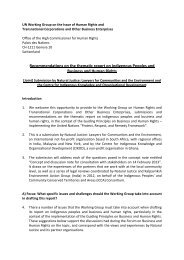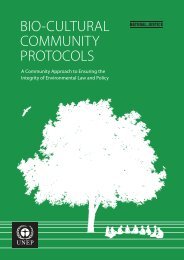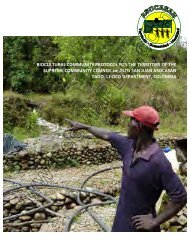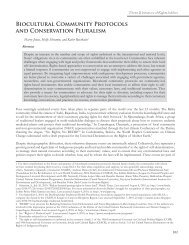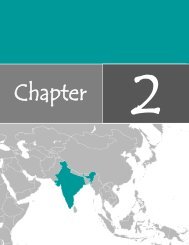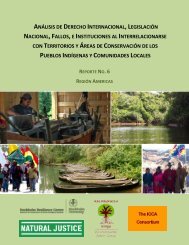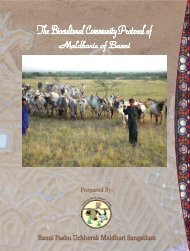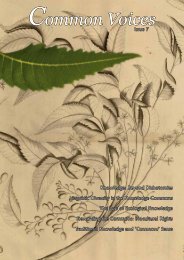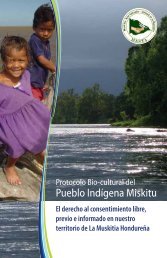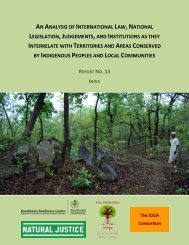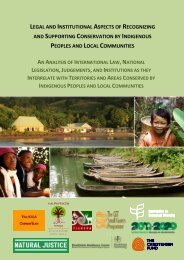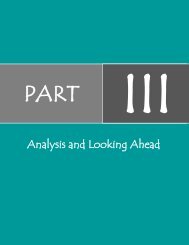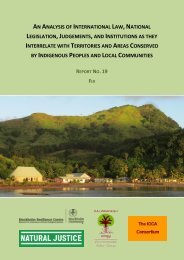Analyzing The Binding Nature of COP Decisions ... - Natural Justice
Analyzing The Binding Nature of COP Decisions ... - Natural Justice
Analyzing The Binding Nature of COP Decisions ... - Natural Justice
Create successful ePaper yourself
Turn your PDF publications into a flip-book with our unique Google optimized e-Paper software.
hard law. Thus, amendments to the CBD, protocols, and amendments to protocols, which require express consent from Parties before they are bound, should constitute hard law. 47 Annexes and amendments thereto deviate from the traditional treaty-‐law formation in that they require opting out in order to avoid being bound. As set forth in Article 11 <strong>of</strong> the Vienna Convention, however, “[t]he consent <strong>of</strong> a State to be bound by a treaty may be expressed ... by any other means if so agreed.” It could be argued that the opt-‐out process in the CBD is another means by which Parties can express consent. Even if a literal interpretation <strong>of</strong> the term “express consent” is taken, Parties still have the opportunity to determine whether or not to be bound by an annex or amendment thereto. On the other hand, the legal weight <strong>of</strong> actions which take place outside <strong>of</strong> this context (such as certain <strong>COP</strong> <strong>Decisions</strong>) are “at best ambiguous.” 48 In regard to <strong>COP</strong> <strong>Decisions</strong> in particular, “they do not appear to be binding in a formal sense.” 49 According to Brunee, “[t]o the extent that parties understand some <strong>of</strong> the rules contained in the relevant decisions as ‘mandatory’ and agree to subject themselves to their terms, the distinction between <strong>COP</strong> decisions that are, technically speaking, legally binding and those that are not may well be more apparent than real.” 50 It is important to note that some commentators argue that traditional treaty analysis is inadequate to address the scope <strong>of</strong> <strong>COP</strong> decision-‐making. 51 Brunee “argue[s] for an interactional understanding <strong>of</strong> international law … [where] international law arises from a mutually generative process, [meaning that] … actors come to understand themselves and their interests in light <strong>of</strong> their interaction with others and in light <strong>of</strong> the norms that frame the interaction.” 52 <strong>The</strong> point here is that rather than focusing on whether or not a decision was made within the formal confines <strong>of</strong> traditional treaty law, decisions are analyzed according to general concepts <strong>of</strong> transparency, mutual understanding, and customary practice. 4.4 Other Issues 46 “Actions” encompasses all activities <strong>of</strong> the <strong>COP</strong>, including adoption <strong>of</strong> protocols and issuance <strong>of</strong> <strong>Decisions</strong>. 47 See Churchill and UlfsteinUlfstein, at 636 (noting that <strong>COP</strong> treaty amendment procedures “essentially reflect the general procedures for treaty amendment laid down in the Vienna Convention on the Law <strong>of</strong> Treaties, though in institutionalized and more streamlined form”). 48 Brunee, at 32. 49 Brunee, at 32. 50 Brunee, at 32-‐33. 51 Brunee, at 6. 52 Brunee, at 33 and 34.



